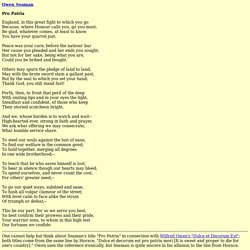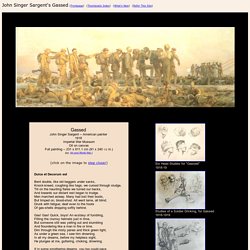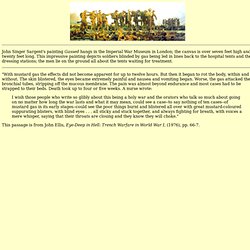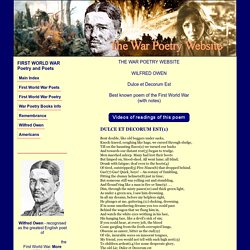

The Soldier. 7. How to Die. Sassoon, Siegfried. 1918. Counter-Attack and Other Poems. WW1: Siegfried Sassoon's poem How to Die in animation. Pro Patria. Owen Seaman Pro Patria England, in this great fight to which you go Because, where Honour calls you, go you must, Be glad, whatever comes, at least to know You have your quarrel just.

Peace was your care; before the nations' bar Her cause you pleaded and her ends you sought; But not for her sake, being what you are, Could you be bribed and bought. Others may spurn the pledge of land to land, May with the brute sword stain a gallant past; But by the seal to which you set your hand, Thank God, you still stand fast! Forth, then, to front that peril of the deep With smiling lips and in your eyes the light, Steadfast and confident, of those who keep Their storied scutcheon bright.
And we, whose burden is to watch and wait-- High-hearted ever, strong in faith and prayer, We ask what offering we may consecrate, What humble service share. To steel our souls against the lust of ease; To find our welfare in the common good; To hold together, merging all degrees In one wide brotherhood;-- British_55th_Division_gas_casualties_10_April_1918.jpg (1200×743) John Singer Sargent's Gassed. Gassed John Singer Sargent -- American painter 1918 Imperial War Museum Oil on canvas Full painting -- 231 x 611.1 cm (91 x 240 1/2 in.)

Jpg: Art and World War I (click on the image to step closer) Dulce et Decorum est Bent double, like old beggars under sacks, Knock-kneed, coughing like hags, we cursed through sludge, Till on the haunting flares we turned our backs, And towards our distant rest began to trudge. Men marched asleep. Many had lost their boots, But limped on, blood-shod. If in some smothering dreams, you too could pace Behind the wagon that we flung him in. -- Wilfred Owen (1917)
Sargent's Painting. John Singer Sargent's painting Gassed hangs in the Imperial War Museum in London; the canvas is over seven feet high and twenty feet long.

This impressive painting depicts soldiers blinded by gas being led in lines back to the hospital tents and the dressing stations; the men lie on the ground all about the tents waiting for treatment. "With mustard gas the effects did not become apparent for up to twelve hours. But then it began to rot the body, within and without. The skin blistered, the eyes became extremely painful and nausea and vomiting began. Worse, the gas attacked the bronchial tubes, stripping off the mucous membrane. This passage is from John Ellis, Eye-Deep in Hell: Trench Warfare in World War I, (1976), pp. 66-7. Horace 'The Odes' Book III. Book III Translated by A.

S. Kline © 2003 All Rights Reserved. Dulce Et Decorum Est. WW1: Siegfried Sassoon's poem How to Die in animation. 7. How to Die. Sassoon, Siegfried. 1918. Counter-Attack and Other Poems. VirtuaLit: Elements of Poetry. Pro Patria. British_55th_Division_gas_casualties_10_April_1918.jpg (JPEG Image, 1200 × 743 pixels) - Scaled (85%) Pro Patria. Sargent's Painting. Dulce Et Decorum Est. WILFRED OWEN - DULCE ET DECORUM EST, Text of poem and notes. WILFRED OWEN Dulce et Decorum Est Best known poem of the First World War (with notes) Bent double, like old beggars under sacks, Knock-kneed, coughing like hags, we cursed through sludge, Till on the haunting flares(2) we turned our backs And towards our distant rest(3) began to trudge.

Men marched asleep. Many had lost their boots But limped on, blood-shod. All went lame; all blind; Drunk with fatigue; deaf even to the hoots(4) Of tired, outstripped(5) Five-Nines(6) that dropped behind. Wilfred Owen Thought to have been written between 8 October 1917 and March, 1918 Notes on Dulce et Decorum Est 1. 2. 3. 4. Poetry Explications. What this handout is about A poetry explication is a relatively short analysis which describes the possible meanings and relationships of the words, images, and other small units that make up a poem.

Writing an explication is an effective way for a reader to connect a poem’s plot and conflicts with its structural features. This handout reviews some of the important techniques of approaching and writing a poetry explication, and includes parts of two sample explications. Preparing to write the explication Read the poem silently, then read it aloud (if not in a testing situation). The large issues Determine the basic design of the poem by considering the who, what, when, where, andwhy of the dramatic situation. What is being dramatized? The details To analyze the design of the poem, we must focus on the poem’s parts, namely how the poem dramatizes conflicts or ideas in language.